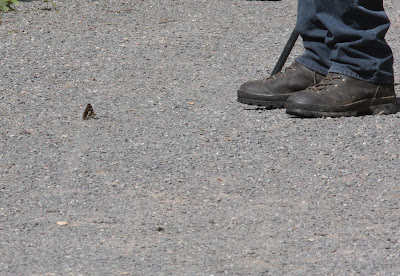By Royal Appointment
A sunny day was too much to resist. Purple Emperors would surely be on the wing and with a three week life span the days are running out fast to see them. The Audi was pointed south and at 1045 I was wandering down the track through Bernwood Forest to make a rendezvous with Badger. Meeting up we wandered onwards down the track and just past the stream by the meadow came across our first Purple Emperor regally feeding by the side of the track. Apparently oblivious to our close proximity we watched it, photo'd it, video'd it, and ooohed! and aahhed! at it, marvelling at its long yellow proboscis probing the gravel for nutrients.

It remained there for at least an hour during which my camera battery ran out! I went back to the Car Park to get a spare and on the way walking back came across no less than four more Emperors scattered singly along the edge of the track feeding on savoury dog turds. Rejoining Badger and friends and after more homage to the still static Emperor we then walked back towards the Car Park but had only gone a few metres when we found another Emperor on the ground. More video for Badger, but no more photos for me as it was settled on a large dog turd but then his Majesty ascended into an Oak to sun himself. That's better!

A lady came past and told us she had just seen three much further back along the track in the other direction. It did not take much persuading for Badger and myself to turn round and head in that direction.We encountered three more Emperors on our walk bringing a total of around ten individuals seen during our morning amble. Some were looking fairly worn with gaps in their wings while others looked almost pristine.


Its such an enjoyable and pleasant experience just wandering around looking for and finding them. Everyone who passes even if not specifically looking for butterflies is interested and a general air of bonhomie and goodwill pervades the area. Even the dog walkers not usually known for their consideration cooperate and control their pooches. Just standing looking at these marvellous creatures for long periods prompts me to ponder about various aspects concerning their appearance.Why does the purple on the wings show so much better when the insect is viewed from head on rather than from the rear?

Why are they called purple when the iridescence is really blue? Mind you Blue Emperor does not have the same pizzaz as Purple Emperor does it? And purple is after all the traditional colour of Emperors.Why is it that only the males seem to want to come to feed on the ground? What do the females feed on? This day was really exceptional and do you know tomorrow is meant to be even more sunny and warm.Guess where I am going!
Supporting cast seen along the track were Silver Washed Fritillaries, Purple Hairstreaks, Marbled Whites, Ringlets, Meadow Browns, Red Admiral, Small Tortoiseshell, Large White, Large Skipper, Emperor Dragonfly, Brown Hawker, Common Darter, Beautiful Demoiselle and a Hornet
































